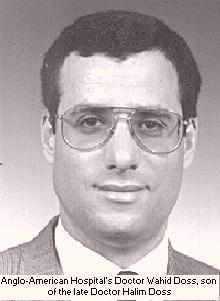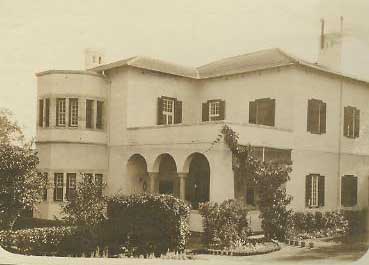
|
|
|
|
|
Cheers to our "talented" literature prize awardee. Your pain his gain !!!
|
|
|
EGY.COM - ZAMALEK
|
|
by Samir Raafat
Egyptian Mail, January 13, 1996; Cairo Times May 28, 1998

When the British Army of Occupation was holed up inside the Kasr Al Nil barracks, the red faced Tommies must have found some comfort in the colonial landmarks surrounding them. To the south stood the new British Legation from where Lord Cromer ran Egypt's day-to-day affairs. North of the barracks, plans were in the offing for an All Saints Cathedral (now, the 6th of October flyover). Further away, next to the new synagogue on Sharia Al Magrabi (today, Adly Street) stood the Turf Club (former British agency/consulate). And across the Nile dividing the palm-decked island of Gezira in two, were the Khedivial Sporting Club polo fields.
Soon, another visible landmark would come to join the collection of post-Victorian icons. The Anglo-American Hospital, known unto most simply as The Anglo.
There was talk of a private hospital for the growing number of British civilians even before Sir Horace Pinching had taken over the Department of Public Health in 1902. The idea was formally put forward at the Savoy Hotel on Midan Soliman Pasha during a March 1901 meeting between Lord Cromer and Judge John Long, the American consul. As a result, it was announced that subscriptions and donations for a new Anglo-American Hospital were now welcome. The site for the hospital was south of the Khedivial Club's racecourse on several feddans especially purchased from the Egyptian government by Lord Cromer for LE1600.
By February 1903, the required money was raised save for the hospital's Maintenance Fund. To make up the difference, a social gathering was held at the Grand Continental Hotel on Midan Ibrahim Pasha (Al Opera). "The ball came off with the greatest éclat," wrote the British-owned Egyptian Gazette.
"The arrangements for the ball, which were carried out under the personal supervision of Mr. George Nungovich (the hotel's manager), were perfect. The whole of the right wing of the ground floor of the hotel had been placed at the disposal of the dancers, and the two rooms composing the restaurant were thrown into one and formed a most commodious and excellent ball-room which, although 150 couples must have been dancing in it at times, never became overcrowded. The terrace of the hotel had been covered in with an Arab tent, carpeted with soft rugs, and brilliantly lit up with innumerable lights, forming a delightful place to sit out in. The ballroom itself was tastefully decorated, the intertwining of the British and American flags being a special and gratifying feature of the decorations. The Rifle Brigade band was brought in for the occasion and certainly no fault could be found with either the music or the floor. Under these circumstances it is hardly necessary to say that last night's ball was the most brilliant function of this or any past season, and we expect the event of its becoming a perennial institution, it will be looked upon as the clou of the Cairo season. It would be far easier to say who was absent than who was there. We were sorry to notice the absence of Lord Cromer, who, we hear, was slightly indisposed. He was however, ably represented by Lady Cromer. Dancing was kept up with the greatest zest until 2 o'clock this morning, when the company dispersed."
A month later, the LE6363 Anglo-American Hospital designed by John Price Bey of the Health Department was completed. At the advice of Natali Prosperi, the hospital's Italian contractor, the opening was deferred until autumn when the building would become thoroughly dry. It was just about the time the Anglo received its first patient in the autumn of 1903, that a malaria epidemic hit the Nile Delta and a rampant cholera outbreak was announced in Palestine and Suez.
A modest venture with 22 beds, the Anglo contained special, private and general wards charging respectively 100, 30 and 15 piasters per day. Owing to the generosity of Sir Hugh Houston Smiley and poet Leigh Hunt, two beds were available for those without means. The Anglo's largest benefactor was Sir Ernest Cassel, a close confidant of King Edward. When he died, the hospital's reliance on donations and subscriptions from British and American corporations operating in Cairo increased substantially.
During the first 50 years of the Anglo's operation, preference was given to British and American nationals. Management was vested in an executive council elected out of a general committee of 24 members. The envoys of Great Britain and the United States were ex-officio chairman and vice chairman respectively.
It would be thanks to two of Britain's officials that the Anglo made world headlines. In November 1924, Sir Lee Stack, Commander of the Egyptian army and Governor-General of the Sudan expired there following an assassination attempt by Egyptian nationalists. Twenty years later the British Minister of State, Baron Edward Walter Guinness (a.k.a. Lord Moyne), was proclaimed dead-on-arrival, from three fatal bullet wounds courtesy of two Zionist terrorists.
Between the two World Wars, the Anglo broke with its unwritten rules and allowed non-British Fellows of the Royal College of Surgeons on the premises. This was how Abdel Wahab Mouro Pasha and Naguib Mahfouz Pasha (not to be confused with Egypt's Nobel Laureate) became the first Egyptians to practice there on a consultancy basis.
During World War II the Anglo became a British-run military hospital. Fred Clayton recalls he was admitted to what was then known as the 15th. Scottish General Hospital at Gezira, Cairo. The name refers to the Military medical people who operated it. "I recall that it was quite close to the cricket ground on Gezira - I enjoyed watching some of the games when I was recovering from illness. It was on the Eastern side of the island overlooking the River Nile."
The last British administrator of the Anglo was reportedly a brother-in-law of General Montgomery. He lived on a nearby houseboat next to the hospital.
Following the Suez Crisis of 1956, the hospital, like other British interests in Egypt, was sequestered. "For three days the Anglo-American hospital was in the throes of the Egyptian Air Force which wanted it for its own exclusive use. But through presidential intervention the hospital reverted to a special panel that undertook its temporary administration until a new one was re-constituted in 1961" recalls Halim Greiss MD. "New by-laws were introduced to reflect the post-1952 changes. Unfortunately, the hospital's balance sheets plunged into the red as traditional sources of income dried up overnight."
Gone were the British and American companies that had provided the necessary funds for general maintenance and upkeep of what was for all intents and purposes a benevolent organization. Gone, also, were the charity balls and well-attended fund-raisers so crucial to the hospital's welfare. It was thanks to one of these events that the main building's large elevator was purchased in 1938.
The Anglo-American also suffered when a sizable part of its fixed assets was amputated by the state. According to a Doctor Halim Grace, the adjacent building had once belonged to the Anglo. In the early 1960s it was used as a state interrogation center, when chilling human cries cut through the still nights "frightening the Anglos' patients, inducing early labor in the nearby maternity ward, once the exclusive preserve of chief gynecologist, Doctor Walter Hodes Hamilton."
While Greiss believes the Cairo Tower stands on former hospital property, Henry Pelham-Burn thinks the tower stands on the property that was once part of Sir Frederick Rowlatt's residence, "The house in Zohria, belonged to the Egyptian government. After 1950, when my grandfather died, it was taken over by the military."

Could the Rowlatt residence this have been the infamous interrogation center of the 1960s? In any case, the villa-turned-house-of-horrors was the first residential building in Zohria (aside from the hospital's Sisters House). First Occupied in 1914 by Dr. Graham who headed the Public Health Service Department it was subsequently handed over to Major General Julian Byng. During the interwar period the villa was thoroughly overhauled and handed over to the governor of the National Bank of Egypt, Frederick Rowlatt.
The leading Egyptian practitioners at the now 'de-sequestrated' Anglo-American Hospital included several leading MDs. Most prominent among them was veteran Doctor Halim Doss who was later joined by Doctors Halim Greiss and Samir Massoud.
"In 1985, in recognition of my father's long-term contributions to the medical profession, the hospital's (original) intensive care unit was re-named the 'Doctor Halim Doss Unit' remarks Shahira Doss whose brother Wahid and sister Laila carry on their father's excellent name at the Anglo.
Having already celebrated its centennial, the 100-bed hospital is desperate for a heavy dose of re-organization and a face-lift to boot. The only novel elements in evidence are smart young doctors armed with mobile phones, beepers and hi-tech gadgets, somewhat incongruous with the decaying surroundings. But to the antiquated hospital's credit, the atmosphere remains congenial. The de-humanization factor one so often encounters in modern sanatoriums and spotless clinics has not yet reared its unsightly head at the Anglo.
From: Ted Darling
Date: Tuesday, August 28, 2007 12:07 PM
I was born at the Anglo American Hospital in 1945. My nurse was a Sister Shankshaft (SP). My mother was Greek, Olga Darling nee Mitilinious married to William Henry Darling, who's father served with British forces at Khartoum, Atbara and Omdurman. Stayed in Egypt till death! My father attended Victoria College and played football around the 1926's -1930's for Gezira Sporting Club. We left as a family in 1948 to come to New Zealand. Any queries please sing out. Love to catch up.
Subject: Anglo-American Hospital: Approaches Its Centennial - Article
Date: Thu, 1 Aug 2002 21:24:39 +1000
From: Hugh & Maryrose Crowther
CC: "Pam & Ronnie Elgar"
I have just read your article on the Anglo-American Hospital with some interest. The article mentions the gift of a bed to that hospital by Sir Hugh Houston Smiley who is the grandfather of a close friend of mine - Ronald H Elgar who asked me to
respond on his behalf. Ronald's mother was the daughter of Sir Hugh and an event occurred on his yacht whilst sailing off the coast of Egypt that changed her life forever. As a small child at the time she contracted a severe ear infection that resulted in her being evacuated to a nearby hospital for treatment which proved to be too late, she became profoundly deaf in both ears from that time. We are not sure when this event occurred. Ronald presumes the gift of the bed and this event are related and would very much appreciate if you could advise what year this gift was made and other connection if any between his randfatherand the hospital.
Yours Faithfully,
Hugh Crowther
|
|
|
|